New Mars Forums
You are not logged in.
- Topics: Active | Unanswered
Announcement
#1 2014-02-16 11:36:31
- robertwalker
- Banned
- Registered: 2012-06-03
- Posts: 31
Where Should we Send our Rovers to Mars to Look for Early Life?
You might like this article I just did for my science20 blog:
Where Should we Send our Rovers to Mars to Unravel Mystery of Origin of First Living Cells?
It's quite topical as the deadline for submission of candidate sites for ExoMars is 28th February of this year.
This is about early life, which is the target for ExoMars, I plan another similar article later on present day life.
It's a vast multi-disciplinary subject - I did my best - but if any of you spot any errors or omissions do say. Really interested in any comments on it - you can comment on the article itself as well as here.
Also, what are your own favourite places to search for life from Early Mars, Noachian and Hesperian periods?
Last edited by robertwalker (2014-02-16 11:43:43)
Offline
Like button can go here
#2 2014-02-16 12:57:21
- SpaceNut
- Administrator
- From: New Hampshire
- Registered: 2004-07-22
- Posts: 29,599
Re: Where Should we Send our Rovers to Mars to Look for Early Life?
Site selection has for a starting point question in do we go to a place that we have already gone to in order refute a previous finding or to corelate a simular finding.
Then from the previous sites one could go through there respective runners up list to see if there are any sites of interst to exomars preference list and then to add new sites into the main list before down selection based on rover capabilities.
Then secondary thoughts are to select site that are pertinent to a manned follow up missions and or to do testing that allow for a manned landing to have predata that is needed for insitu use.
Offline
Like button can go here
#3 2014-02-16 14:12:25
- robertwalker
- Banned
- Registered: 2012-06-03
- Posts: 31
Re: Where Should we Send our Rovers to Mars to Look for Early Life?
Yes well ExoMars could go to any of the previous landing sites and do new science, because of its capability to dig one meter below the surface, that by itself is enough reason. Even Viking couldn't do that and of course its instruments were cruder also.
Then, with its ability to do sensitive tests for biosignatures, for instance if it could get to Gale Crater (which it can't sadly) it could analyse the same deposits Curiosity anlaysed and see if they have biosignatures of life, in a way that Curiosity can't do.
If not now, eventually our rovers we send now are probably just pioneers for more sophisticated rovers we can send to the same spots later on as technology improves.
I think that they are likely to go to Mawrth Vallis because it's an interesting site to visit and fits their very restrictive requirements, but who knows...
As for human landings on Mars, I think myself that if we do land humans on Mars it won't be for at least quite a few decades, because it's such a complex planet to study. We don't want to send humans to the surface at least until we understand it thoroughly iin its pristine state.
Humans in orbit around Mars could speed this up via telepresence operation of rovers on the surface. But I don't see any role at all in humans on the surface, in spacesuits for the exploration for organics and signs of life, just because there is no way we know that humans could explore Mars in that way without taking a trail of contamination with them wherever they go which would confuse the hugely sensitive instruments we want to send to Mars to look for life there.
Plans to use humans on the surface always had the base in an uninteresting place unlikely to have any traces of organics, far away from any sites of special interest, sending rovers to the more interesting places by remote control to pick up the samples to avoid contaminating them - but it makes much more sense now to do all that from orbit not from the surface, especially as the surface of Mars turns out to be a little more habitable for life than we thought just six years ago. It also costs far less to send humans to orbit, and safer, so a more feasible mission to do at an early stage, once we have safe interplanetary flight.
BTW this is a list of the sites for the first round of candidate selection for Curiosity
http://marsoweb.nas.nasa.gov/landingsit … e_list.pdf
More about the selection process here
http://marsoweb.nas.nasa.gov/landingsites
And voting results:
http://marsoweb.nas.nasa.gov/landingsit … esults.pdf
Last edited by robertwalker (2014-02-16 14:22:23)
Offline
Like button can go here
#4 2014-03-22 12:07:50
- Quaoar
- Member
- Registered: 2013-12-13
- Posts: 665
Re: Where Should we Send our Rovers to Mars to Look for Early Life?
For life sercing, the best sites are those with water: sending Exomars on a buried glacier may be very interesting (Elysium Planitia, Protonilus Mensae, Hellas Basin etc...): in one unmanned mission we can search life and make geological prospection, finding a water source for a future manned surface mission (I fear that a more than 500 days manned orbital mission will result in mental insanity for the astronauts even if they have a 100 ton habitat with a perfect artificial gravity and cosmic radiation shielding system).
Last edited by Quaoar (2014-03-22 12:22:42)
Offline
Like button can go here
#5 2014-03-22 15:51:18
- SpaceNut
- Administrator
- From: New Hampshire
- Registered: 2004-07-22
- Posts: 29,599
Re: Where Should we Send our Rovers to Mars to Look for Early Life?
For what ever site is selected One issue is how large is the rover and then what life detection intruments will be onboard. Then one must ask are we only looking for past life and whether we will even state any current exitance if it is found.
Offline
Like button can go here
#6 2014-03-23 07:56:02
- Quaoar
- Member
- Registered: 2013-12-13
- Posts: 665
Re: Where Should we Send our Rovers to Mars to Look for Early Life?
For what ever site is selected One issue is how large is the rover and then what life detection intruments will be onboard. Then one must ask are we only looking for past life and whether we will even state any current exitance if it is found.
Searching for past life may be very difficoult for an unmanned rover, unless it has the luck of running in a fossil. Present life (if exist) can be easy to detect in ice samples.
Offline
Like button can go here
#7 2014-12-27 03:29:08
Re: Where Should we Send our Rovers to Mars to Look for Early Life?
With the recent reports of liquid water being possible on Mars as brines, I like the Noctis Labyrinthus region because of the frequent low lying fogs:
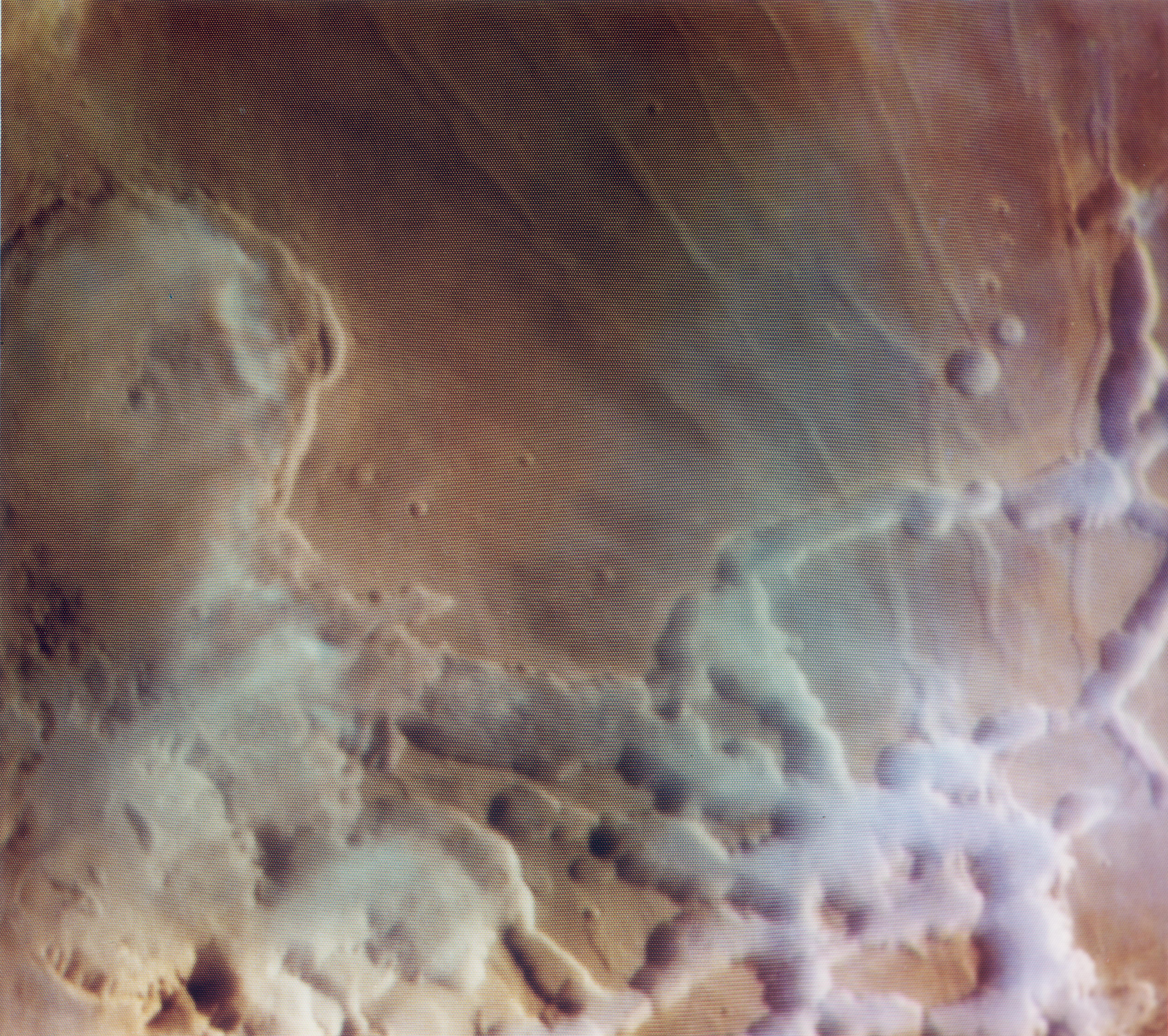
Bob Clark
Last edited by RGClark (2014-12-27 03:30:24)
Old Space rule of acquisition (with a nod to Star Trek - the Next Generation):
“Anything worth doing is worth doing for a billion dollars.”
Offline
Like button can go here
#8 2014-12-28 16:07:45
- Void
- Member
- Registered: 2011-12-29
- Posts: 8,761
Re: Where Should we Send our Rovers to Mars to Look for Early Life?
I will suggest a possibility.
With cycling temperatures, salt absorbing water from the atmosphere, I think sandstone, or soil for that matter, might create small amounts of brine under the surface at some locations some of the time. Freezing temperatures will separate a part more salty from a part less salty. So it will push the brine out of equilibrium. When the less salty part melts at the next day, it might be the most usable by life as a solution to absorb water from. I also think that the two salt solutions might also provide energy for the microbes.
http://en.wikipedia.org/wiki/Reversed_electrodialysis
I am guessing from the dates on the article above, that it has not worked out as a machine process, however the article below continues with it.
http://pubs.acs.org/doi/abs/10.1021/es5005413
I certainly might not know what I am talking about here, but it seems to me membranes and cells go together, and if there is an energy source, I can at least speculate on an organism harnessing it.
Mars offers solar, chemical, and perhaps this energy. To find life near the surface, brine does offer the best chances for a solvent, as far as I could speculate. It might also offer an energy source which does not require exposure to U.V light.
And if this is worthy of speculation, it also points to a method for life to be powered in Europa, and other underground seas.
Sandstone, may allow light into the near surface, so maybe is is a good choice for life that might use several energy sources, or a community of life that each uses one, solar, chemical, or salt differential.
Away from the equator, I would speculate that water ice deposited over salty soil might also offer a seasonal habitat.
I suppose it is a long shot, but I would think that a search might be done to see if any organism can utilize a difference in salt between two liquid layers. For instance I think many bodies of water have differential salt layers. An Antarctic Dry Valley lake has briny water at the bottom, and less salty at the top.
A river running into the great salt lake for instance might be a place to look. Tidal pools.
Of course, other Earth organisms might have suppressed the development of such organism by being more competitive and pushing them to extinction or preventing them from developing. But I would think that if science actually does not dismiss the idea, it would be worthwhile to look for such on Earth. A more precise analog might be in a high salt desert in Tibet, or other mountain ranges. Preferably where a day night cycle repeatedly freezes and thaws a salty soil.
Most salt water differentials would require the organism to move long distances to experience first the more salty and less salty. However a freeze/thaw of salty soil might provide a short term differential, where a single droplet of salty water was the habitat which each cycle is separated into differential fluids by freezing and thawing.
Last edited by Void (2014-12-28 17:26:54)
Is it possible that the root of political science claims is to produce white collar jobs for people who paid for an education and do not want a real job?
Offline
Like button can go here
#9 2014-12-28 23:46:11
- SpaceNut
- Administrator
- From: New Hampshire
- Registered: 2004-07-22
- Posts: 29,599
Re: Where Should we Send our Rovers to Mars to Look for Early Life?
Noctis Labyrinthus region sure looks intriguing http://www.esa.int/Our_Activities/Space … _the_night
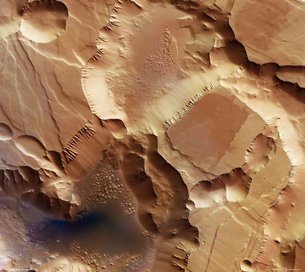
I would head towards the lower left corner as that looks like it would have been a lake.
Offline
Like button can go here
#10 2014-12-29 12:39:16
- Void
- Member
- Registered: 2011-12-29
- Posts: 8,761
Re: Where Should we Send our Rovers to Mars to Look for Early Life?
OK, signs of ancient life.
I would wonder how old these features are, how buried they are. That is if you are going to look for ancient life, it could have been buried and exhumed by processes over time.
One thing that I would be interested in is seeps in the walls of canyons. If ancient, then wind may have worn off the stains, but perhaps the cracks can be identified?
Those locations would be hard to access however being vertical.
I wonder if the study of permafrost springs in the permafrost regions of the high Arctic could reveal rules about where springs are likely to have occurred in these regions under certain climate conditions.
If you might have had a lake, it is possible that it was spring fed, in a location with such changes in altitude. As the lake might have dried up, then the springs might have been the last gasp of surface life.
Moving forward in time for a moment, I would have to speculate that under conditions where the equator were glaciated, where the atmospheric pressure was just a bit higher, it is not out of the question that snow pack could have melted and charged aquifers even in the last few million years.
For this reason, I would not even entirely rule out the existence of seeps even now, but they would evaporate as soon as the water emerged to the surface. (Unless briny).
But going back, I suppose the acid phase of water might very well have done in any life that might have existed in ancient times, except perhaps underground, if an aquifer was not too salty.
That dark patch does look interesting.
A spring on Mars would benefit from being covered with an ice covered lake, that is the most likely situation where the permafrost would thaw enough to permit a persistent artesian well-up. A transition from artesian water to lake water might cause chemicals to deposit, which might preserve evidence of life I suppose. Perhaps the life would have even used the contrasting water chemistry to drive it's metabolism.
Is it possible that the root of political science claims is to produce white collar jobs for people who paid for an education and do not want a real job?
Offline
Like button can go here
#11 2014-12-29 15:09:45
- Void
- Member
- Registered: 2011-12-29
- Posts: 8,761
Re: Where Should we Send our Rovers to Mars to Look for Early Life?
Here is another possibility:
http://www.oilonmars.blogspot.no/
I don't necessarily buy into everything he thinks, however, he does suggest mud volcano's, and there are observed some "Potential" mud volcano's on Mars observed by independent sources.
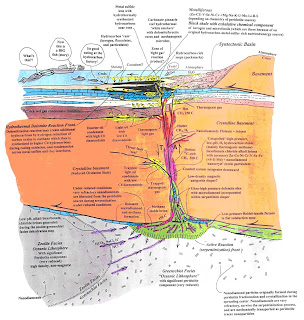
Figure 7. This illustration, by Stan Keith and Monte Swan (2004) shows the whole concept of why serpentinization is so important for life on Earth. The process has also been active on Mars, but has probably not lead to life there (because of the difficult atmospheric situation, where liquid water is not stable).
The Serpentosphere has enormous and novel implications for four major geologic problems that are of current interest to the geologic and social community:
1) the driving mechanism for plate tectonics,
2) the origin of life,
3) the origin of hydrocarbons, and
4)contributions to global climate.Because the Serpentosphere has been continuously generated since the beginning of geologic time it must be considered as one of the fundamental entities of our water-surfaced planet – the only water-planet we know of ...(Keith et al., 2008).
Stan Keith profile
So to me this serpentinization is very important, because you could have a circumstance where a body of ice is built up over suitable rock, and it would sit static for a long time like a fireplace full of wood where no source of ignition was provided. However if a quake or perhaps even a slight atmospheric warming (From a actual Volcano?) were to occur, and a trickle of melt water were to run into those rocks, heat can be generated from a chemical reaction, and that could further mix the rock and water and cause a run away reaction.
That could generate significant Methane, and temporarily alter the climate of Mars.
Figure 7. This illustration, by Stan Keith and Monte Swan (2004) shows the whole concept of why serpentinization is so important for life on Earth. The process has also been active on Mars, but has probably not lead to life there (because of the difficult atmospheric situation, where liquid water is not stable).
The Serpentosphere has enormous and novel implications for four major geologic problems that are of current interest to the geologic and social community:
1) the driving mechanism for plate tectonics,
2) the origin of life,
3) the origin of hydrocarbons, and
4)contributions to global climate.Because the Serpentosphere has been continuously generated since the beginning of geologic time it must be considered as one of the fundamental entities of our water-surfaced planet – the only water-planet we know of ...(Keith et al., 2008).
Stan Keith profile
4. Mud Volcanism
Mud volcanism is one of the strangest and least understood geological processes on Earth and Mars. A mixture of liquified minute clay particles, water (brine and pure H2O), gas (methane and carbon dioxide), and oil continuously wells up in these special volcanoes. It is only very rare that heat is associated with them, - normally they have ambient temperatures. The photo below shows a typical onshore mud volcano south of Baku, in Azerbaijan. The four components (mud, water, gas, and oil) are here present.
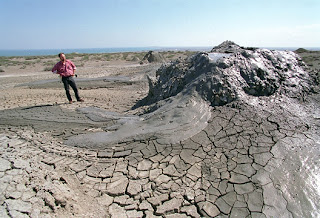
Figure 10. A so-called 'gryphon' on the large Dashgil mud volcano south of Baku (from Hovland et al., 1997). Liquid mud, gas, and oil is tranported naturally from an unknown depth below ground to the surface. The gryphons are associated with pure (fresh) water, as salty water (brine) does not transport mud to surface
The next image, is a conceptual presentation of the Dashgil mud volcano, where the above photo has been taken.
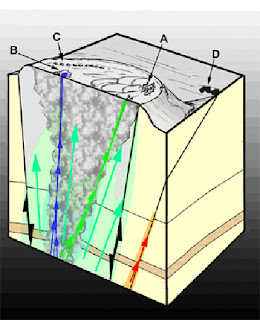
Figure 11. A conceptual block diagram of Dashgil mud volcano. The above photo was taken at 'A', i.e., at the gryphons, caused by fresh water (condensation water) flow to surface. 'B' shows a 'salse', which is a brine pool, caused by salt water flow to surface (blue arrows). 'C' is a line of sinter cones, demonstrating that there has been fire on the mud volcano at one instance (forming burned clay - sinter). 'D' is a pool of crude oil, showing that oil is also transported within the mud volcano, but is diverted outside the main conduit some depth below ground.
Mud volcanoes in the Gulf of mexico
There are even mud volcanoes on top of the fishing banks and natural sanctuaries "East and West Flower Garden Banks" in the northern Gulf of Mexico. Why are they there? To us, the reason is simple: These banks are formed on top of deep-rooted salt domes, that tap hydrothermal fluids at depth. Some of the surplus fluids rise through the internal central conduits of the salt domes and issue through their tops. This is where the mud volcanoes and underwater brine lakes occur. This is also where small amounts of hydrocarbons issue to the water column and fertilizes the local biosphere (i.e., the banks).
Look for the supporting evidence here:
Finally this is from a different set of people, a different article:
http://news.sciencemag.org/2011/04/scie … -volcanoes
So, perhaps this could hold evidence of underground life ejected to the surface at some time in the past.
It does not replace the materials you have presented. They are two different things, but it is interesting as well.
Finally, if Serpentization can occur on Mars, perhaps Fracking to cause it occur, could provide Methane on the cheep for terraforming Mars.
Last edited by Void (2014-12-29 15:14:13)
Is it possible that the root of political science claims is to produce white collar jobs for people who paid for an education and do not want a real job?
Offline
Like button can go here
#12 2014-12-29 22:17:40
- SpaceNut
- Administrator
- From: New Hampshire
- Registered: 2004-07-22
- Posts: 29,599
Re: Where Should we Send our Rovers to Mars to Look for Early Life?
The wonders of google...
Mud Volcanoes on Mars
Oehler and Allen analyzed images obtained from the Mars Reconnaissance Orbiter, If life does - or did - exist on Mars, signs of such life might well be found in a region in the northern plains called Acidalia Planitia
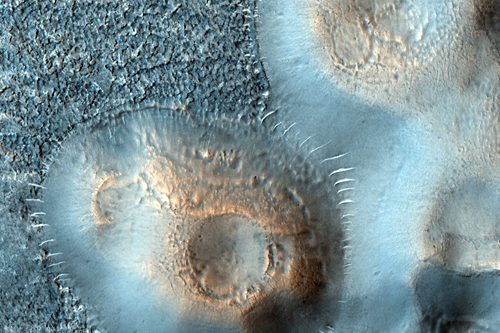
The mounds shown here, located in the Southern Acidalia Planitia, range in size between 20 and 500 meters in diameter
Tanaka points to a Martian valley called Athabasca Valles as a good alternative location for astrobiologists to search for biosignatures.
Seems that the list of places to go is getting larger....
Offline
Like button can go here
#13 2015-01-08 11:14:51
- Void
- Member
- Registered: 2011-12-29
- Posts: 8,761
Re: Where Should we Send our Rovers to Mars to Look for Early Life?
This persons notions look reasonable to me:
http://www.space.com/28194-mars-rover-c … -life.html
Although Noffke makes a tantalizing case for possible signs of ancient life on Mars, her report is not a definitive proof that these structures were shaped by biology. Getting such confirmation would involve returning rock samples to Earth and conducting additional microscopic analyses, a mission that isn’t scheduled anytime in the near future.
"All I can say is, here's my hypothesis and here's all the evidence that I have," Noffke says, "although I do think that this evidence is a lot."
Is it possible that the root of political science claims is to produce white collar jobs for people who paid for an education and do not want a real job?
Offline
Like button can go here
#14 2017-08-19 09:42:45
Re: Where Should we Send our Rovers to Mars to Look for Early Life?
With the recent reports of liquid water being possible on Mars as brines, I like the Noctis Labyrinthus region because of the frequent low lying fogs:
http://www.ridingwithrobots.org/wp-cont … A03213.jpg
Bob Clark
Water ice found near Mars’s equator could entice colonists and life-seekers.
Find also poses climate puzzle.
SCIENCEMAG.ORG
http://www.sciencemag.org/news/2017/08/ … fe-seekers
Very interesting finding. Daytime surface temperatures near the equator can be well above freezing. That raises the possibility of liquid water near surface at these sites.
Could Curiosity or Opportunity visit one of these sites?
One of these sites might be a good location for the Mars 2020 rover.
Noctis Labyrinthus is my favorite site for the Mars 2020 rover because of its frequently low lying fogs and clouds. This may be indicative of the near surface water ice now known to exist at equatorial sites such as Noctis.


Bob Clark
Old Space rule of acquisition (with a nod to Star Trek - the Next Generation):
“Anything worth doing is worth doing for a billion dollars.”
Offline
Like button can go here
#15 2019-11-24 21:54:54
- SpaceNut
- Administrator
- From: New Hampshire
- Registered: 2004-07-22
- Posts: 29,599
Re: Where Should we Send our Rovers to Mars to Look for Early Life?
Fog would be a good place to search...
How do we find fossils with a machine that does not know what its looking at.... you send Nasa people to do just that
NASA scientists train to spot Martian fossils in the Australian Outback

stromatolites, the oldest confirmed fossilized lifeforms on Earth, in the Pilbara region of North West Australia
Offline
Like button can go here